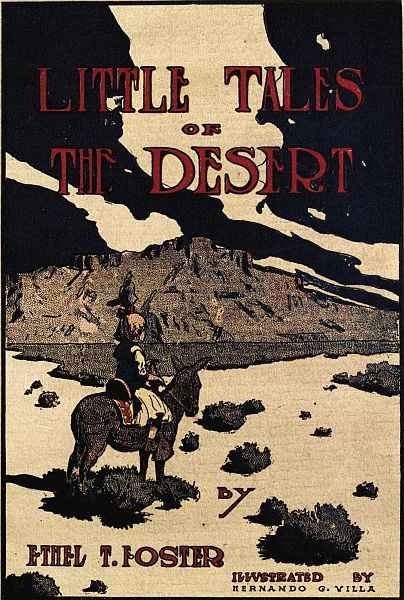
Project Gutenberg's Little Tales of The Desert, by Ethel Twycross Foster This eBook is for the use of anyone anywhere at no cost and with almost no restrictions whatsoever. You may copy it, give it away or re-use it under the terms of the Project Gutenberg License included with this eBook or online at www.gutenberg.org Title: Little Tales of The Desert Author: Ethel Twycross Foster Illustrator: Hernando G. Villa Release Date: December 15, 2009 [EBook #30686] Language: English Character set encoding: ISO-8859-1 *** START OF THIS PROJECT GUTENBERG EBOOK LITTLE TALES OF THE DESERT *** Produced by David Edwards, Emmy and the Online Distributed Proofreading Team at https://www.pgdp.net (This file was produced from images generously made available by The Internet Archive)

| CHRISTMAS ON THE DESERT | 5 |
| TRADE RATS | 7 |
| A CHAT WITH MRS. COTTONTAIL | 9 |
| RABBITS AND CACTUS BURRS | 11 |
| THE DANGEROUS PET | 13 |
| A VISIT TO PALM SPRINGS | 15 |
| THE ROAD-RUNNER | 17 |
| A STRANGE CAPTURE | 19 |
| A DESERT MAY PARTY | 21 |
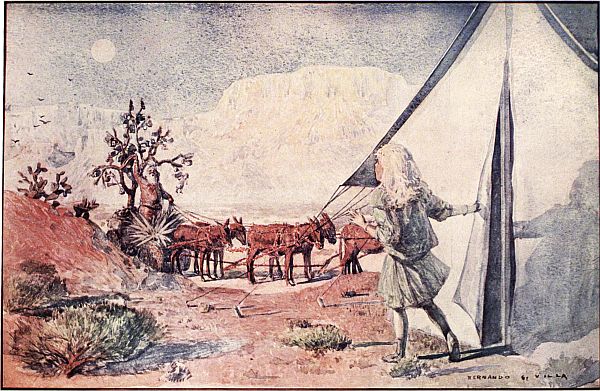 Christmas on the Desert
Christmas on the Desert
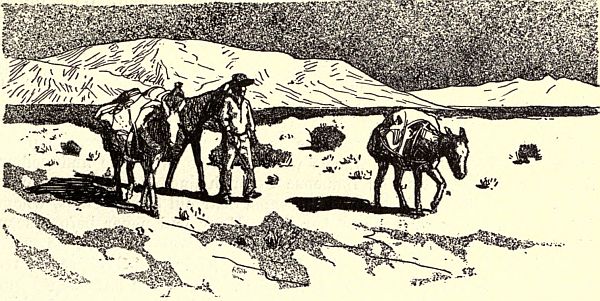

Mary and her mother had joined her father at his mine, where they were going to spend the winter, sleeping in a tent, eating in a tent, but spending the remainder of the time out of doors, under the clear, blue sky and breathing the sweet, pure air.
Mary enjoyed all these things and no troubled thought crossed her mind until the approach of Christmas. She sought counsel with her mother, but Mother merely looked wise and said "wait." Mothers, somehow, seem to know all about these things and Mary had great confidence in hers, and so she ceased to worry, but still she wondered.
Christmas Eve at last arrived and Mary with many misgivings retired early, as children often do in order to hasten the coming of the day. She slept well, but awoke just as the sun came peeping up from behind the distant mountains.
She sat up on her cot very suddenly and rubbed her eyes. What was that rapidly moving object coming over the brow of the nearest [6]hill? She hurried into her clothes and went out. As the speck came nearer it began to take definite form. But how strange! What did it all mean? Mary stood and stared with wide open eyes. Quickly it came nearer and nearer and presently rolled over the nearest rise and swung up in front of the camp.
Mary had seen many interesting sights during her short life of six years, but never one so strange.
First came twelve little burros with harnesses nearly hidden by holly berries, while behind was the queerest chariot that ever popped out of a fairy tale. The wheels were covered with blue and yellow flowers and above was an immense Spanish dagger with the center removed, and in its place stood the same dear old Santa Claus, whom Mary had seen every year of her life. Mary had never before seen him in his desert costume. Instead of his warm fur coat, he wore a kakhi coat and trousers, with high top boots, a bright red scarf around his neck and a wide sombrero hat. Below the hat peeped out the same kindly, bright eyes above the rosy cheeks and snowy white beard. Beside him, instead of the usual evergreen tree, a large, queer, crooked limbed joshua tree, was standing. It was literally laden with presents, and all was lighted up, not with candles or wax tapers, but with the crimson blossoms of the Spanish dagger. On every dagger point was hung a gift. There were grown up presents for father and mother and the cook and the miners; and there was a real doll with blue eyes and teeth, that said "Papa," and "Mama," and cried exactly like the dolls found in far away New York. There was a tea set and a little kakhi suit. There was a cute little set of furniture made from cactus burrs, to say nothing of the delicious cactus candy, and other sweetmeats which must have come from a far away town.
Santa descended with a bow and a smile to all, distributed the gifts, joined them for a moment at breakfast, for the dear old man works very hard and gets hungry, and then with a cheery, "Merry Christmas to all," he was off again, leaving behind one of the little burros named Bepo, for Mary's own use.
As he sped away over the sand toward the next camp, Mary gave a sigh and turned to her mother with a happy laugh, saying, "I guess Santa looks after the little girls and boys everywhere, doesn't he, Mamma?"

Mary and her mother lay on a bunk and beyond the partition one could hear the even breathing of father and cousin Jack. All else was still save the occasional cry of a night hawk or the far distant call of a coyote.
Slowly, cautiously, stealthily into this silence crept a tiny object. Its sharp, black eyes flashed fire in the moonlight and in its small mouth it carefully carried a cactus burr.
"Pst! Mary, did you hear something?" It was cousin Jack's hoarse whisper that broke the silence and awakened Mary from a beautiful dream and her eyes popped open wide. She snuggled closer to Mother and stared into the moonlight. All she could hear was a funny, little scratching sound, unlike any she had ever heard around camp, and she knew not what it meant. None of her little animal friends made a noise like that.
Jack was out of bed, had lighted a candle and in his pajamas, was searching under bunks, tables and chairs for the thing that had caused the noise. Mary sat up in bed, in time to hear a swift, rustling sound and see a small object dart out of the tent door. Jack knew it would do no good to search outside so tumbled back into bed and once more all was still.
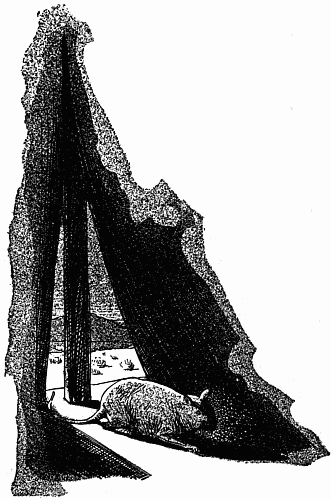
Next morning at breakfast all were wondering who the strange visitor could have been, but soon the incident was forgotten. Toward noon, Mary went to a vacant bunk where she kept her clothes, and picked up her new doll. She removed its dress and looked about for a little, red, wool gown, of which she was very fond, for the day was chilly and it looked like rain. But the gown was gone, high and low she looked, but find it she could not. At last, tired out with searching, she fell asleep, and the pretty lost gown remained a mystery.
During the next few days strange things happened. On the day following one of Dolly's stockings was gone, on the next, its mate; on the next[8] a pretty little velvet bonnet, and so on for a week. The strangest part of it was that something or somebody was bringing in little sticks of wood and cactus burrs and piling them up among the doll clothes.
At the end of the week, Jack decided to solve the mystery. He said he was going to sit up all night and see what kind of a thing was coming into the tent so regularly. He didn't do exactly what he intended to do, for by ten o'clock his eyelids grew too heavy and he was fast asleep in the vacant bunk which he had chosen for a hiding place.
Patter, patter, patter, something was coming. Jack awoke with a start of expectation. There was no moon tonight, but he had left a candle burning in a distant corner. It was all he could do to keep back a chuckle when he saw a big gray rat dart across the floor with a good sized twig in its mouth. Jack kept perfectly still and the little fellow, not even seeing him, continued its way across the floor to the bunk on which sat Jack beside the doll clothes. It clawed its way up the side of the bunk, dropped the twig, then selected a soft, woolly skirt. Then it turned and scampered away through the door and out into the sagebrush.
Jack gave a hearty laugh and at once awakened the whole family and told them his story.
"Of course," said Father, "it was a trade rat. Why didn't we think of that before? The hills are full of tiny holes where they burrow down and build their nests."
"But what about the twig?" asked Jack.
"They always pay for what they take," was the unexpected reply, "they are great fellows to steal both food and clothing, but they never take anything without replacing it with a cactus burr, a twig, a chip of wood, or something of the sort. They seem to think it wrong not to leave something in place of what they take."
"But what did they do with all my dolly's clothes?" asked Mary, "surely they can't wear them."
"Indeed no, my dear little girl," said Father, "but probably if you could find their nest, you would see them busy at work lining it with the soft, downy cloth in preparation for a family of little ones."
Mary talked and wondered about all these happenings, and you can imagine her delight when big Joe came running up to camp one day and told her he had found her rat's nest. The men had been digging on a little hill preparing to build the foundation of an extra tent. The hill was covered with rat holes and gopher holes, and Joe lifted up a shovel full of adobe and underneath was a little cave all carefully lined with warm clothing. On the soft bed lay mother rat and six tiny little fellows with eyes just opened. They were peering around with a frightened look and giving shrill little squeaks of dismay.
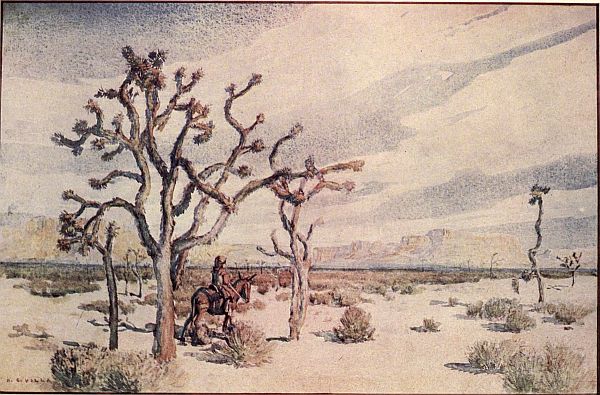 Joshua Trees (Mary and Bepo)
Joshua Trees (Mary and Bepo)
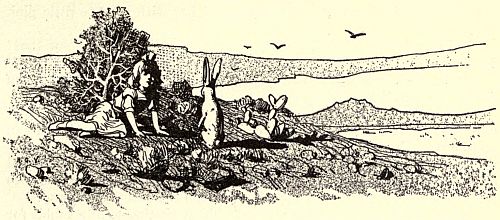

She followed along a little trail leading over a small hill east of camp. Upon arriving at the top she noticed a clump of trees beyond, and they looked so cool and shady that she trotted down the trail and sat beneath them.
Now this was a dangerous thing to do, for she could no longer see home, and there were many trails leading in all directions. A little girl of six years could hardly be expected to remember the way back.
She was soon rested and decided to start for home. She was getting hungry, too. A tiny hill rose from the clump of trees in every direction, which one ought she to choose? She was not a child to be daunted by a thing like this, so boldly started up the path she thought led home. She climbed to the top, but no camp was in sight, no tents, no horses, nothing to indicate the surroundings of those dear people that she did want dreadfully to see, O! so quickly.
"Oh me, oh my, I guess I'm lost!" she cried with a little break in her voice. "I hope there are no bears in these hills. Oh, why did I run away, and where is my mamma?"
She ran back down the hill, throwing herself on the ground under the trees while the great big tears chased down her rosy cheeks. "Can I help you, little girl?" said a tiny voice near by, "you are getting your pretty dress soiled and your hair will be full of sand."
"Oh, I didn't know rabbits could talk," and Mary's eyes grew big and round with wonder. There before her stood a little cottontail[10] perched upon its haunches and blinking at her with its cute little pink eyes.
"Yes, we desert rabbits could always talk, didn't you know that? But, where is your mamma and what are you doing out here alone?"
"I guess I'm lost," answered Mary, "but you live here, can't you find my home?"
"No, dear little girl, I can't, and I will tell you why. Mr. Man with many brothers and sisters lives in your home. Mr. Man has a gun and he uses that gun to kill poor little rabbits like me. Don't you remember eating some for dinner yesterday? Well, on that day several of our dear little playfellows were killed. Now you see I don't care to be eaten, so must not go near your home, even to show you the way."
Mary gave a little shudder, for she did remember eating rabbit for dinner the day before and that she liked it, too; but she made a resolve never to do so again.
"But I'll not desert you for all that," continued the strange friend. "My home is close by and as you are but a wee bit of a girl and have no gun, I'll take you there."
Mary was delighted. To visit a real rabbit village and to be taken there by Mrs. Rabbit, herself, would be a strange adventure, indeed.
Mrs. Rabbit led the way down a narrow path worn by the little feet of her numerous family. Mary trotted along behind when suddenly the rabbit stood up, gave a jump and darted away into the bushes.
Mary, startled, looked up in surprise. There stood cousin Jack gazing down at her with an amused twinkle in his eyes; why! she, herself, was lying, her head pillowed on her chubby arms, directly under the shady tree where she had thrown herself in despair but a few moments before.
"Well, little girl, what have you been dreaming about?" he asked. "Mother is sure you are lost or eaten up by some of your wild friends."
At this, Mary stood up and looked around indignantly. "Did I really dream about all those dreadful things Mrs. Cottontail told me?" she said.
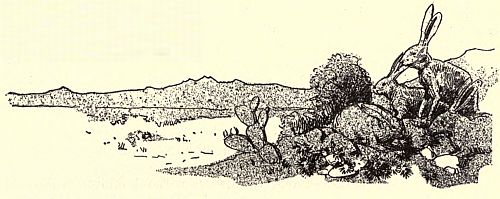

You city children and even you country boys and girls would never dream of all the delightful and interesting things they found. I suppose you think of the desert as being a flat stretch of sand with nothing on it, like the maps of the desert of Sahara, in Africa? I know I used to. But indeed it is not so. Many strange forms of life exist, both plant and animal, as we shall soon learn.
This particular morning as they started out, Mary noticed that the ground was covered with cactus burrs. Did you ever see a cactus burr? They are similar to those you find in the country, but larger, with pointed daggers sticking out in all directions, and they grow on a crooked, prickly stalk or spine in the most comical way imaginable. As they ambled along they discovered more and yet more of them. Mary, being an inquisitive child, jumped down from Bepo's back for a closer inspection of the strange things. Then she discovered a queer thing. She had seen lots of burrs before but these were different. All the sharp daggers had been removed, the burrs had been split open and the soft centers taken out.
Mary looked all around, who could have done it? No man could have opened all those burrs, it would have taken him weeks. He would have pricked his fingers many times and often besides.
Then she heard a faint rustling in the bushes near by. Softly she tiptoed behind a clump of sagebrush and peeked over. There was a little rabbit nibbling away at a cactus burr. He handled it very carefully to guard against pricks and very daintily nibbled off, one by one, the tiny daggers. When all were gone he split open the burr, sucked[12] out the juice, then nibbled up the soft center. So you see, even on this sandy desert, Nature cares for all her children.
Mary was so pleased at the sight that she clapped her little hands in glee and cried, "You dear, cute little thing!" But Mr. Rabbit was not used to little girls. He looked up suddenly with fright in his tiny pink eyes, then sprang away into the bushes.
Mary led Bepo around to a rock and clambered onto his back. As they slowly stubbed along over the rough trail they surprised many a family of rabbits and not a few were nibbling away at the prickly cactus burrs.
You can ride for miles over the desert without finding water, no lakes, no rivers, no little stream even; and if it were not for the sweet juices in the center of these burrs many small animals would die of thirst.
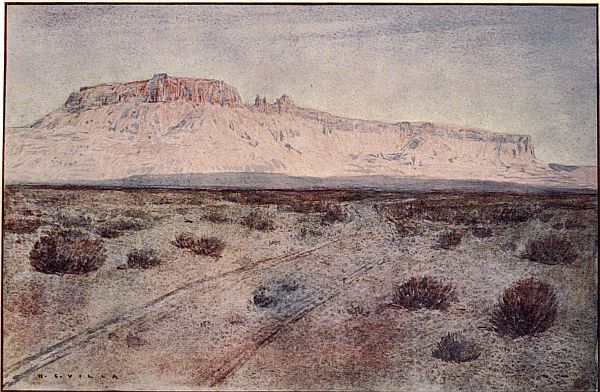 Twilight on the Desert
Twilight on the Desert
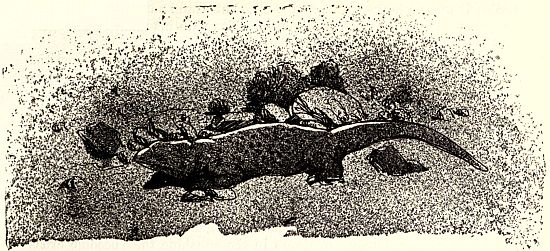

At the end of that month big Ben, the foreman, came into Mary's tent to repair the floor. The first Mary knew that anything was wrong was when he gave a scream, calling to her to keep away from the tent. Her father, nearby, ran to see what was the trouble; Ben pointed to the big lizard and cried, "A gila monster, let us kill him quickly!" Mary and her parents looked at him in surprise. They had never heard of such an animal. Ben, however, had spent years on the desert and knew well its dangers. But he had no gun and all he could do was to take a stick and push the thing out of doors. Then a queer thing happened. When the hot sun shone down on the gila monster (pronounced[14] heela) it was no longer tame and gentle, but would snap at anyone who came near and acted ugly, continuing to hiss with his mouth wide open, on the lookout for the first sign of an enemy.
A squirrel came out of the brush and ran a bit too near, when the big lizard fastened its fangs in the poor little animal and turned over with it in its mouth. The poison is in its lower jaw and when he turns over it flows out. The squirrel died in a very few moments from the effects of the poison in spite of the fact that Ben had meantime shot the gila monster through the head.
Mary's parents were horrified when they realized what a dangerous pet their little girl had been playing with for so many weeks. They determined to seek Ben's advice hereafter before housing any more strange animals.
But Mary was not in great danger for generally the little reptiles are tame indoors, but out of doors in the sunshine they become cross and ugly and their bite is more dangerous than that of a rattlesnake.
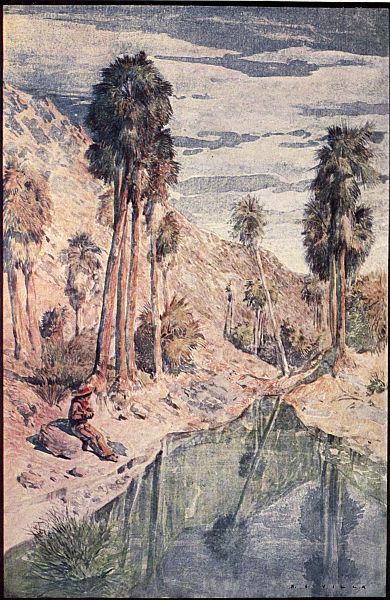 Palm Springs
Palm Springs

Now, Palm Springs is in California near the great Mountain of San Jacinto and it took a day and a half to get there. It was great fun for Mary and Jack to get into a sleeping car and go speeding along over the desert again. They recognized many of their old friends on the way, most of whom they knew nothing about the last time they rode on a train. Then it grew dark and they could no longer see out of the window. The next morning after breakfast the conductor opened the door and called out, "Palm Springs." They hurriedly gathered together their bags and suitcases and left the train. My! but wasn't it cold, and didn't the wind blow? Folks could hardly stand straight and the wind was blowing right off the snow-capped mountains that were all around the place, making it seem colder still. Mary was hurried into the stage and before they had gone a mile their faces were covered with sand blowing off the desert and you could never have told that their clothes had ever been clean.[16] Palm Springs itself was five miles from the station, but suddenly the wind stopped blowing and it was warm as summer, then pretty soon they heard dogs barking and rode right through an Indian village. Some of the squaws were making baskets, but most of them were out in the fields working just like men. Imagine Mamma doing work like that. It was interesting to see them, though, especially the little papooses being carried in a little box fastened to the mother's back. |
Just beyond was Palm Springs settlement itself, with lots of tents, several houses, a store and a hotel. They stopped at the hotel, and after dinner looked around the funny little store where they sold a little of everything while a phonograph ground out wheezy music. They visited the funny little cottages with their roofs and sides all covered with big palm leaves instead of boards. Then they went up to the hot springs.
There was a stream of water shooting up in the air part of the time, but generally just bubbling up a little higher than the pond itself, which was about six feet wide and ten feet long. It didn't look deep, but the man at the springs told them the center shaft was sometimes as big as a well and no one knew how deep. Father had been there before and he wanted to take Mary into the spring, so with Jack they hired bathing suits and went down. It was very funny. They thought, of course, it was going to be deep, but the bottom was hard sand, and the water just covered their ankles. Father took Mary in first, but the water did not become deeper, but all at once the sand gave way. Father said it was quick sand which somewhat frightened her, but he didn't seem scared so she tried not to be. They went down and down into the sand which seemed to tighten around them, when all at once, when Mary was up to her shoulders, the spring gave a gurgle and tossed them out into shallow water. Mary was frightened, but the rest laughed at her, especially Jack, who was fourteen and thought he was almost a man. He said he could walk around in it all right—the old water could not toss him up like that. It was just bubbling over a little then, so he marched boldly in. But when he felt the warm watery sand hugging him tighter and tighter and sucking him down, he thought surely he was lost and wished he had not bragged. But just then the spring gurgled louder and a high stream shot up and in it was Cousin Jack, who landed safe and sound beside them. I can tell you he was a happy boy.
They soon became accustomed to the idea and spent an hour of fun wading in and being gently but firmly tossed out. Then they went back to Dr. Murray's Hotel where Mother met them at the door. After a supper of fresh eggs, nice biscuits, strawberries and cream, they retired to their tent and when all were in bed Father rolled up the sides so they could look out at the stars and breathe the fresh, warm air softly blown to them by the gentle mountain breezes.
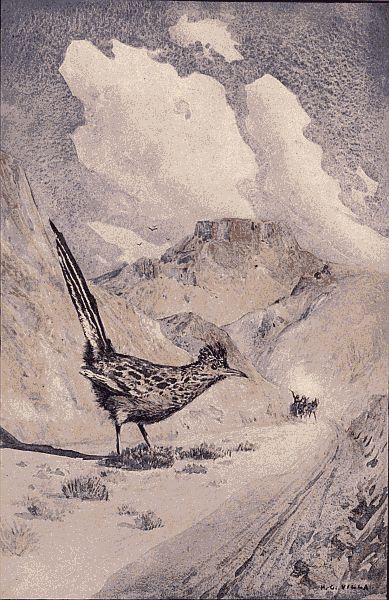 The Road Runner
The Road Runner


A pair had built a nest in a clump of cactus a short distance from camp. The first time Mary espied them was the day after her arrival. One came up over a low ridge and stood looking at Mary with curiosity expressed in its long, flexible tail. This, of course, aroused Mary's interest and she hastened away to make friends. But it was not to be. Very quickly the bird retreated to its cactus patch. But it came again the next day and the next.
At first Mary was afraid of frightening it away, but one day it came as she was eating a thick slice of bread and butter and she tossed it some crumbs. As before, he scampered away to a safe distance, but there he stopped. Mary stepped back and waited and pretty soon the little fellow returned and rapidly ate up all the crumbs. He then gave a little toss of his tail as if to say "thank you," and went home.
After this Mary and the little road-runner soon became fast friends, and later Mary taught him that Cousin Jack was his friend, too. He soon learned that the big horn that the cook blew three times a day meant something to eat; and was always on hand to get his share. He would always save a goodly part of this share and carry it home to his mate.
Mary and Jack each had a burro and often they would take short rides to the nearby camps, for Jack was a steady, reliable boy and Mary's father knew he would take care to see that no harm came to her.[18]
The trail led by the road-runner's nest and whenever he saw the little girl and the big boy coming along on their burros he would dart out into the road and rush ahead at full speed. He could always keep ahead, too. Try as they might Mary and Jack were unable to get ahead of him. When he grew weary of the sport he would turn suddenly and hurry into the brush until they had passed.
In some ways, though, he was a nuisance. Mary's uncle had sent them a box containing a dozen chickens so that they could have some fresh eggs as a change from the cold storage eggs commonly found in mining camps. Now, the little road-runner would often try to slip into the chicken yard when no one was looking. He would wait indifferently, promenading up and down in a dignified manner until one of the hens cackled. He knew this meant a fresh egg and he would deliberately march up, peck a hole in the new laid egg and as deliberately swallow the contents.
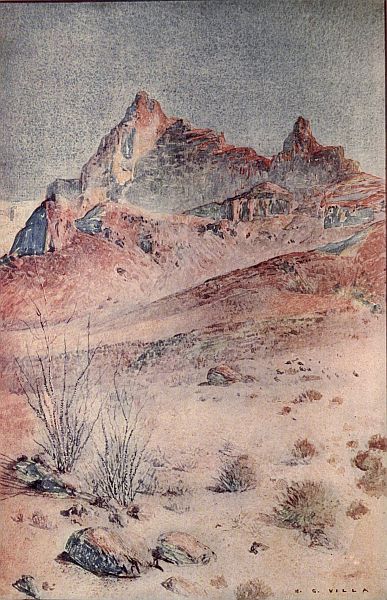 Colorado Desert (Ocatilla in foreground)
Colorado Desert (Ocatilla in foreground)
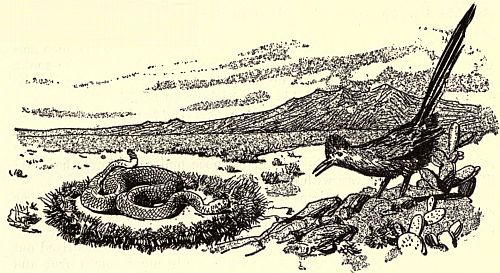

Here it stretched itself out at full length, and after enjoying the warmth of the sunshine for a little while, gradually grew drowsy and at last fell asleep.
Exactly one hour later, a faint rustling sound was heard. From behind the same rock peeped out an excited looking little creature. It was no other than our little friend the road-runner. But why so agitated and disturbed? Its little tail was bobbing up and down, and its beautiful bluish-black crest was raised as high as possible. He had spied his lifelong enemy, the rattlesnake.
Suddenly, as quickly as he came, he disappeared from sight. He was soon back, carrying in his beak a cactus burr, which he placed on the ground near the sleeping snake. Back and forth he went, each time returning with a prickly burr. Before long he had a hedge entirely surrounding poor, unsuspecting Mr. Snake. Then one more burr was brought and quietly dropped on the snake's head.
Now, the skin of a snake is very sensitive and he immediately woke up. Of course his first motion rubbed the delicate skin against the prickly burr. He gave a vicious rattle and started to move away from the troublesome thing. He struck at one side of the hedge, then another. He grew more and more angry. He would try to poke his nose between the burrs, but on being pricked by the sharp points, he would draw back and try in another place. At last, overcome with anger and[20] mortification, he drove his poisonous fangs into his own body and soon died.
Mr. Road-runner, meanwhile, had retreated to a safe distance and was much interested in all that was happening. When sure the snake was dead, he cautiously darted up to the hedge and gave the dead snake a series of sharp pecks with his long beak as an additional safeguard. Then he settled down and ate a portion, carrying the best part away to his nest to share with his mate.
Now, if that snake had kept his temper and not become excited, he might have realized that by poking his nose under the burrs he could lift them and get away with only a few scratches.
However, there are times when even boys and girls let their anger get the best of them, so why should we expect more wisdom in a poor, foolish snake!
Sometimes the snake doesn't kill itself, but only becomes tired out and lies down motionless, when the little road-runner comes over and pecks him to death. There are only a few animals, birds or insects who can kill a rattlesnake, and the road-runner does this about as neatly as any.
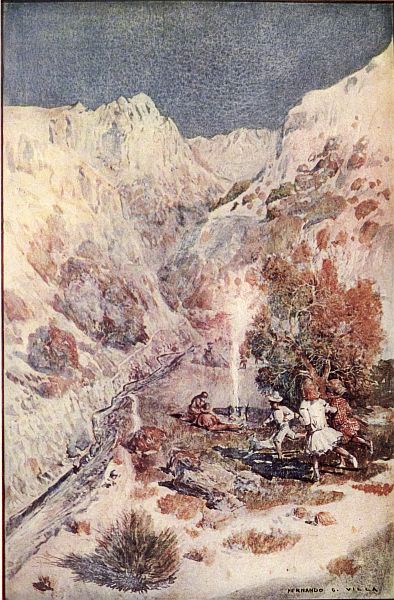 A Desert May Party
A Desert May Party
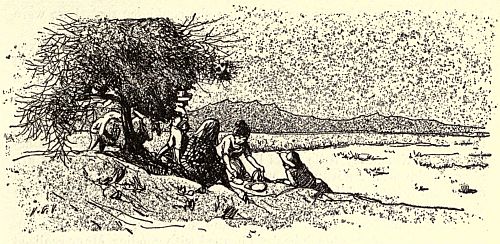

Ah, yes, my dear, I used to think so, too, but to Mary it was no surprise. She had spent the winter on the desert, had seen the heavy rains, and afterwards had watched how rapidly the sturdy little green shoots would push their way up through the hard unsympathetic soil. Generally once a year the desert puts on its party dress and is dotted with a gorgeous mass of blossoms.
The rains come at intervals in the winter and early spring and the heavier and more frequent they are, the greater will be the flower growth. The March and April rains this year had been heavy. There had been days when Cousin Jack had come in with his raincoat dripping and declared that he knew Mt. Kenyon would be washed away. Now and then a cloudburst would strike terror to Mary's tender heart. She had gone out when the weather cleared and watched the warm earth rise up and break, while the little green things peeped through and took their first look at the sun. The ground was always warm and it was amazing to see how rapidly things would grow if you but gave them water.
The thing that now troubled Mary was the fact that she had no one to ask to share her party. Of course there was Jack, but Jack was only a boy and a May party, above all else, means girls.
It is strange what unexpected things happen at times, even in lonesome mining camps. The thought had barely entered her little curly head when she looked away over toward the mountains and saw a big, lumbering wagon, drawn by four strong horses, come creeping down[22] the road. Long before it reached camp she could see that there were several people on it and then she saw the children.
There were four of them, three little blue eyed girls with flaxen hair and a slightly older brother with the same light hair but who looked at the world through a pair of big, laughing brown eyes. They were staying twenty miles up the valley with their parents who had charge of a small cattle ranch, and Mother and children were having a holiday going to town with Father. They stopped to water the horses and you may be sure that it did not take long for the children to become acquainted. Not many little folks live on the desert and playmates are almost unknown. As it turned out, Father and Mother went on to town alone and left the children to enjoy one another until their return on the following day.
Mary's mother was always planning surprises, so when she appeared with two large lunch baskets heaped with goodies, Mary realized that this would be a May day party unlike any she had ever before seen. Six burros were kept ever ready in the corral and these were caught and saddled for the children. Mother rode her Indian pony, a Christmas gift from Father. As they passed the mill and wound up the trail by the main shaft of the mine, the men were changing shift and as the cage swung up to the surface the miners called a cheery good-bye, for they were very fond of Mary.
They ascended the next rise and what they saw was fairyland. They were at the entrance of a canyon. A tiny stream of water ran in the center and beside it wound a narrow trail. Foothills rolled up on either side and the steep walls were a mass of flowers. Wild heliotrope, thistle, poppies, white, pink and yellow gillias, long-leaved wild tobacco, with its rich yellow blossoms, all were massed together and far more beautifully arranged than the stiff gardens in Central Park.
"Aunt Louise," called Jack to Mamma, who was riding behind with the little girls, "isn't that a campfire up on the next hill?"
"No, Jack," she replied, "not a fire, only a smoke tree. That is why it received its name. The branches are grayish with tiny sage-green leaves and at a distance it is often mistaken for a fire as it is all so delicate and filmy."
By this time Jack had ridden ahead for a closer inspection of the bush and startled us all by a little cry of pain.
"Be careful, Jack, it is also called the porcupine tree by the miners," called Mother, "the tiny leaves are nothing more than very sharp and prickly spines."
"Why is it that so many desert plants have stickers and thorns?" asked Tom, the rancher's son.
"Why, can't you see for yourself, Tom?" called back Jack, "if they weren't sharp and prickly all these little desert animals would tear them up when they were young and tender and they would never grow to be full sized."[23]
"Yes," said Mother, "it is simply the way that nature protects her young so that it will not be destroyed in infancy. There are still other protections necessary on the desert for the hot sun would otherwise kill many plants. A large number are covered with a soft down which is really a mass of tiny air cells that keep the stems and leaves cool and protect them from the hot sun's rays."
"And see, there is a creosote bush, its rich green leaves are covered with a kind of varnish which keeps them cool the same as the hairs would do. See how the recent rains have brought out a mass of blossoms at the tip of every branch, what a delicate flower, held in a pale green cup. And there is another smoke tree, nearer the water and so it has blossomed earlier, every point has a gorgeous purple flower."
"See the funny bunch of sticks over here, Mamma," called Mary, "they look like a lot of candles sticking up."
"And that is just what they are called, my dear, ocatilla, or candle cactus. They have no leaves for the greater part of the year, but after the rains they leave out and are soon covered with those beautiful scarlet bells."
"Yes," answered Mary, "they look like some beautiful winged bird just about to fly away. And how tall the candles are, lots higher than our tents back in camp."
It would take too long to tell you about all the desert beauties that the children saw, they all agreed that nothing as beautiful was ever seen "back East" where it rains half the time.
At noon they sat down under a clump of mesquite and ate the splendid luncheon. The pure fresh air had made them ravenously hungry. The mesquite was a low, stocky tree which did not grow high but spread out in every direction, branches thick with foliage.
"Why don't the old tree grow up higher and not bother about having so many side branches?" asked Jack.
Then Mother told him. "Why, can't you see?" she asked. "The sun is so hot that it kills the tiny buds on the end of the branch; but the tree is determined to grow, just the same, so it sends out side buds, where the sun's rays are not as hot and the short, stubby tree is the result."
"At any rate it makes a fine shade and that is all we need just now," answered Jack.
They rested under the wide spreading branches until the sun shone a bit less fiercely, then they slowly rode homeward through the beautiful blossoms, arriving just at dusk, very hungry, a little tired, but happy in the thought that they had visited one of the strangest and most beautiful corners of the earth.
The original text did not contain a table of contents. One was created for this text.
Khaki is spelled kakhi in this text.
End of the Project Gutenberg EBook of Little Tales of The Desert, by
Ethel Twycross Foster
*** END OF THIS PROJECT GUTENBERG EBOOK LITTLE TALES OF THE DESERT ***
***** This file should be named 30686-h.htm or 30686-h.zip *****
This and all associated files of various formats will be found in:
https://www.gutenberg.org/3/0/6/8/30686/
Produced by David Edwards, Emmy and the Online Distributed
Proofreading Team at https://www.pgdp.net (This file was
produced from images generously made available by The
Internet Archive)
Updated editions will replace the previous one--the old editions
will be renamed.
Creating the works from public domain print editions means that no
one owns a United States copyright in these works, so the Foundation
(and you!) can copy and distribute it in the United States without
permission and without paying copyright royalties. Special rules,
set forth in the General Terms of Use part of this license, apply to
copying and distributing Project Gutenberg-tm electronic works to
protect the PROJECT GUTENBERG-tm concept and trademark. Project
Gutenberg is a registered trademark, and may not be used if you
charge for the eBooks, unless you receive specific permission. If you
do not charge anything for copies of this eBook, complying with the
rules is very easy. You may use this eBook for nearly any purpose
such as creation of derivative works, reports, performances and
research. They may be modified and printed and given away--you may do
practically ANYTHING with public domain eBooks. Redistribution is
subject to the trademark license, especially commercial
redistribution.
*** START: FULL LICENSE ***
THE FULL PROJECT GUTENBERG LICENSE
PLEASE READ THIS BEFORE YOU DISTRIBUTE OR USE THIS WORK
To protect the Project Gutenberg-tm mission of promoting the free
distribution of electronic works, by using or distributing this work
(or any other work associated in any way with the phrase "Project
Gutenberg"), you agree to comply with all the terms of the Full Project
Gutenberg-tm License (available with this file or online at
https://gutenberg.org/license).
Section 1. General Terms of Use and Redistributing Project Gutenberg-tm
electronic works
1.A. By reading or using any part of this Project Gutenberg-tm
electronic work, you indicate that you have read, understand, agree to
and accept all the terms of this license and intellectual property
(trademark/copyright) agreement. If you do not agree to abide by all
the terms of this agreement, you must cease using and return or destroy
all copies of Project Gutenberg-tm electronic works in your possession.
If you paid a fee for obtaining a copy of or access to a Project
Gutenberg-tm electronic work and you do not agree to be bound by the
terms of this agreement, you may obtain a refund from the person or
entity to whom you paid the fee as set forth in paragraph 1.E.8.
1.B. "Project Gutenberg" is a registered trademark. It may only be
used on or associated in any way with an electronic work by people who
agree to be bound by the terms of this agreement. There are a few
things that you can do with most Project Gutenberg-tm electronic works
even without complying with the full terms of this agreement. See
paragraph 1.C below. There are a lot of things you can do with Project
Gutenberg-tm electronic works if you follow the terms of this agreement
and help preserve free future access to Project Gutenberg-tm electronic
works. See paragraph 1.E below.
1.C. The Project Gutenberg Literary Archive Foundation ("the Foundation"
or PGLAF), owns a compilation copyright in the collection of Project
Gutenberg-tm electronic works. Nearly all the individual works in the
collection are in the public domain in the United States. If an
individual work is in the public domain in the United States and you are
located in the United States, we do not claim a right to prevent you from
copying, distributing, performing, displaying or creating derivative
works based on the work as long as all references to Project Gutenberg
are removed. Of course, we hope that you will support the Project
Gutenberg-tm mission of promoting free access to electronic works by
freely sharing Project Gutenberg-tm works in compliance with the terms of
this agreement for keeping the Project Gutenberg-tm name associated with
the work. You can easily comply with the terms of this agreement by
keeping this work in the same format with its attached full Project
Gutenberg-tm License when you share it without charge with others.
1.D. The copyright laws of the place where you are located also govern
what you can do with this work. Copyright laws in most countries are in
a constant state of change. If you are outside the United States, check
the laws of your country in addition to the terms of this agreement
before downloading, copying, displaying, performing, distributing or
creating derivative works based on this work or any other Project
Gutenberg-tm work. The Foundation makes no representations concerning
the copyright status of any work in any country outside the United
States.
1.E. Unless you have removed all references to Project Gutenberg:
1.E.1. The following sentence, with active links to, or other immediate
access to, the full Project Gutenberg-tm License must appear prominently
whenever any copy of a Project Gutenberg-tm work (any work on which the
phrase "Project Gutenberg" appears, or with which the phrase "Project
Gutenberg" is associated) is accessed, displayed, performed, viewed,
copied or distributed:
This eBook is for the use of anyone anywhere at no cost and with
almost no restrictions whatsoever. You may copy it, give it away or
re-use it under the terms of the Project Gutenberg License included
with this eBook or online at www.gutenberg.org
1.E.2. If an individual Project Gutenberg-tm electronic work is derived
from the public domain (does not contain a notice indicating that it is
posted with permission of the copyright holder), the work can be copied
and distributed to anyone in the United States without paying any fees
or charges. If you are redistributing or providing access to a work
with the phrase "Project Gutenberg" associated with or appearing on the
work, you must comply either with the requirements of paragraphs 1.E.1
through 1.E.7 or obtain permission for the use of the work and the
Project Gutenberg-tm trademark as set forth in paragraphs 1.E.8 or
1.E.9.
1.E.3. If an individual Project Gutenberg-tm electronic work is posted
with the permission of the copyright holder, your use and distribution
must comply with both paragraphs 1.E.1 through 1.E.7 and any additional
terms imposed by the copyright holder. Additional terms will be linked
to the Project Gutenberg-tm License for all works posted with the
permission of the copyright holder found at the beginning of this work.
1.E.4. Do not unlink or detach or remove the full Project Gutenberg-tm
License terms from this work, or any files containing a part of this
work or any other work associated with Project Gutenberg-tm.
1.E.5. Do not copy, display, perform, distribute or redistribute this
electronic work, or any part of this electronic work, without
prominently displaying the sentence set forth in paragraph 1.E.1 with
active links or immediate access to the full terms of the Project
Gutenberg-tm License.
1.E.6. You may convert to and distribute this work in any binary,
compressed, marked up, nonproprietary or proprietary form, including any
word processing or hypertext form. However, if you provide access to or
distribute copies of a Project Gutenberg-tm work in a format other than
"Plain Vanilla ASCII" or other format used in the official version
posted on the official Project Gutenberg-tm web site (www.gutenberg.org),
you must, at no additional cost, fee or expense to the user, provide a
copy, a means of exporting a copy, or a means of obtaining a copy upon
request, of the work in its original "Plain Vanilla ASCII" or other
form. Any alternate format must include the full Project Gutenberg-tm
License as specified in paragraph 1.E.1.
1.E.7. Do not charge a fee for access to, viewing, displaying,
performing, copying or distributing any Project Gutenberg-tm works
unless you comply with paragraph 1.E.8 or 1.E.9.
1.E.8. You may charge a reasonable fee for copies of or providing
access to or distributing Project Gutenberg-tm electronic works provided
that
- You pay a royalty fee of 20% of the gross profits you derive from
the use of Project Gutenberg-tm works calculated using the method
you already use to calculate your applicable taxes. The fee is
owed to the owner of the Project Gutenberg-tm trademark, but he
has agreed to donate royalties under this paragraph to the
Project Gutenberg Literary Archive Foundation. Royalty payments
must be paid within 60 days following each date on which you
prepare (or are legally required to prepare) your periodic tax
returns. Royalty payments should be clearly marked as such and
sent to the Project Gutenberg Literary Archive Foundation at the
address specified in Section 4, "Information about donations to
the Project Gutenberg Literary Archive Foundation."
- You provide a full refund of any money paid by a user who notifies
you in writing (or by e-mail) within 30 days of receipt that s/he
does not agree to the terms of the full Project Gutenberg-tm
License. You must require such a user to return or
destroy all copies of the works possessed in a physical medium
and discontinue all use of and all access to other copies of
Project Gutenberg-tm works.
- You provide, in accordance with paragraph 1.F.3, a full refund of any
money paid for a work or a replacement copy, if a defect in the
electronic work is discovered and reported to you within 90 days
of receipt of the work.
- You comply with all other terms of this agreement for free
distribution of Project Gutenberg-tm works.
1.E.9. If you wish to charge a fee or distribute a Project Gutenberg-tm
electronic work or group of works on different terms than are set
forth in this agreement, you must obtain permission in writing from
both the Project Gutenberg Literary Archive Foundation and Michael
Hart, the owner of the Project Gutenberg-tm trademark. Contact the
Foundation as set forth in Section 3 below.
1.F.
1.F.1. Project Gutenberg volunteers and employees expend considerable
effort to identify, do copyright research on, transcribe and proofread
public domain works in creating the Project Gutenberg-tm
collection. Despite these efforts, Project Gutenberg-tm electronic
works, and the medium on which they may be stored, may contain
"Defects," such as, but not limited to, incomplete, inaccurate or
corrupt data, transcription errors, a copyright or other intellectual
property infringement, a defective or damaged disk or other medium, a
computer virus, or computer codes that damage or cannot be read by
your equipment.
1.F.2. LIMITED WARRANTY, DISCLAIMER OF DAMAGES - Except for the "Right
of Replacement or Refund" described in paragraph 1.F.3, the Project
Gutenberg Literary Archive Foundation, the owner of the Project
Gutenberg-tm trademark, and any other party distributing a Project
Gutenberg-tm electronic work under this agreement, disclaim all
liability to you for damages, costs and expenses, including legal
fees. YOU AGREE THAT YOU HAVE NO REMEDIES FOR NEGLIGENCE, STRICT
LIABILITY, BREACH OF WARRANTY OR BREACH OF CONTRACT EXCEPT THOSE
PROVIDED IN PARAGRAPH F3. YOU AGREE THAT THE FOUNDATION, THE
TRADEMARK OWNER, AND ANY DISTRIBUTOR UNDER THIS AGREEMENT WILL NOT BE
LIABLE TO YOU FOR ACTUAL, DIRECT, INDIRECT, CONSEQUENTIAL, PUNITIVE OR
INCIDENTAL DAMAGES EVEN IF YOU GIVE NOTICE OF THE POSSIBILITY OF SUCH
DAMAGE.
1.F.3. LIMITED RIGHT OF REPLACEMENT OR REFUND - If you discover a
defect in this electronic work within 90 days of receiving it, you can
receive a refund of the money (if any) you paid for it by sending a
written explanation to the person you received the work from. If you
received the work on a physical medium, you must return the medium with
your written explanation. The person or entity that provided you with
the defective work may elect to provide a replacement copy in lieu of a
refund. If you received the work electronically, the person or entity
providing it to you may choose to give you a second opportunity to
receive the work electronically in lieu of a refund. If the second copy
is also defective, you may demand a refund in writing without further
opportunities to fix the problem.
1.F.4. Except for the limited right of replacement or refund set forth
in paragraph 1.F.3, this work is provided to you 'AS-IS' WITH NO OTHER
WARRANTIES OF ANY KIND, EXPRESS OR IMPLIED, INCLUDING BUT NOT LIMITED TO
WARRANTIES OF MERCHANTIBILITY OR FITNESS FOR ANY PURPOSE.
1.F.5. Some states do not allow disclaimers of certain implied
warranties or the exclusion or limitation of certain types of damages.
If any disclaimer or limitation set forth in this agreement violates the
law of the state applicable to this agreement, the agreement shall be
interpreted to make the maximum disclaimer or limitation permitted by
the applicable state law. The invalidity or unenforceability of any
provision of this agreement shall not void the remaining provisions.
1.F.6. INDEMNITY - You agree to indemnify and hold the Foundation, the
trademark owner, any agent or employee of the Foundation, anyone
providing copies of Project Gutenberg-tm electronic works in accordance
with this agreement, and any volunteers associated with the production,
promotion and distribution of Project Gutenberg-tm electronic works,
harmless from all liability, costs and expenses, including legal fees,
that arise directly or indirectly from any of the following which you do
or cause to occur: (a) distribution of this or any Project Gutenberg-tm
work, (b) alteration, modification, or additions or deletions to any
Project Gutenberg-tm work, and (c) any Defect you cause.
Section 2. Information about the Mission of Project Gutenberg-tm
Project Gutenberg-tm is synonymous with the free distribution of
electronic works in formats readable by the widest variety of computers
including obsolete, old, middle-aged and new computers. It exists
because of the efforts of hundreds of volunteers and donations from
people in all walks of life.
Volunteers and financial support to provide volunteers with the
assistance they need are critical to reaching Project Gutenberg-tm's
goals and ensuring that the Project Gutenberg-tm collection will
remain freely available for generations to come. In 2001, the Project
Gutenberg Literary Archive Foundation was created to provide a secure
and permanent future for Project Gutenberg-tm and future generations.
To learn more about the Project Gutenberg Literary Archive Foundation
and how your efforts and donations can help, see Sections 3 and 4
and the Foundation web page at https://www.pglaf.org.
Section 3. Information about the Project Gutenberg Literary Archive
Foundation
The Project Gutenberg Literary Archive Foundation is a non profit
501(c)(3) educational corporation organized under the laws of the
state of Mississippi and granted tax exempt status by the Internal
Revenue Service. The Foundation's EIN or federal tax identification
number is 64-6221541. Its 501(c)(3) letter is posted at
https://pglaf.org/fundraising. Contributions to the Project Gutenberg
Literary Archive Foundation are tax deductible to the full extent
permitted by U.S. federal laws and your state's laws.
The Foundation's principal office is located at 4557 Melan Dr. S.
Fairbanks, AK, 99712., but its volunteers and employees are scattered
throughout numerous locations. Its business office is located at
809 North 1500 West, Salt Lake City, UT 84116, (801) 596-1887, email
business@pglaf.org. Email contact links and up to date contact
information can be found at the Foundation's web site and official
page at https://pglaf.org
For additional contact information:
Dr. Gregory B. Newby
Chief Executive and Director
gbnewby@pglaf.org
Section 4. Information about Donations to the Project Gutenberg
Literary Archive Foundation
Project Gutenberg-tm depends upon and cannot survive without wide
spread public support and donations to carry out its mission of
increasing the number of public domain and licensed works that can be
freely distributed in machine readable form accessible by the widest
array of equipment including outdated equipment. Many small donations
($1 to $5,000) are particularly important to maintaining tax exempt
status with the IRS.
The Foundation is committed to complying with the laws regulating
charities and charitable donations in all 50 states of the United
States. Compliance requirements are not uniform and it takes a
considerable effort, much paperwork and many fees to meet and keep up
with these requirements. We do not solicit donations in locations
where we have not received written confirmation of compliance. To
SEND DONATIONS or determine the status of compliance for any
particular state visit https://pglaf.org
While we cannot and do not solicit contributions from states where we
have not met the solicitation requirements, we know of no prohibition
against accepting unsolicited donations from donors in such states who
approach us with offers to donate.
International donations are gratefully accepted, but we cannot make
any statements concerning tax treatment of donations received from
outside the United States. U.S. laws alone swamp our small staff.
Please check the Project Gutenberg Web pages for current donation
methods and addresses. Donations are accepted in a number of other
ways including including checks, online payments and credit card
donations. To donate, please visit: https://pglaf.org/donate
Section 5. General Information About Project Gutenberg-tm electronic
works.
Professor Michael S. Hart was the originator of the Project Gutenberg-tm
concept of a library of electronic works that could be freely shared
with anyone. For thirty years, he produced and distributed Project
Gutenberg-tm eBooks with only a loose network of volunteer support.
Project Gutenberg-tm eBooks are often created from several printed
editions, all of which are confirmed as Public Domain in the U.S.
unless a copyright notice is included. Thus, we do not necessarily
keep eBooks in compliance with any particular paper edition.
Most people start at our Web site which has the main PG search facility:
https://www.gutenberg.org
This Web site includes information about Project Gutenberg-tm,
including how to make donations to the Project Gutenberg Literary
Archive Foundation, how to help produce our new eBooks, and how to
subscribe to our email newsletter to hear about new eBooks.